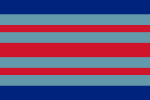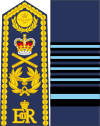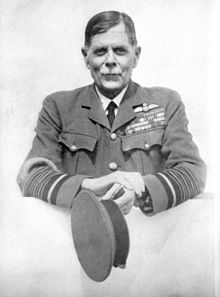
Back Mariscal de la Reial Força Aèria Catalan Marshal of the Royal Air Force German Kuninglike Õhujõudude marssal Estonian مارشال نیروی هوایی سلطنتی Persian Marshal of the Royal Air Force French מרשל של חיל האוויר המלכותי HE Marsekal Besar (Britania Raya) ID Maresciallo della Royal Air Force Italian 空軍元帥 (イギリス) Japanese Marsyal Tentera Udara Diraja Malay
| Marshal of the Royal Air Force | |
|---|---|
 Marshal of the RAF rank flag | |
 Marshal of the Royal Air Force sleeve & shoulder board | |
 A Marshal of the RAF star plate | |
| Country | |
| Service branch | |
| Abbreviation | Mshl of RAF / MRAF |
| Rank | Five-star rank |
| NATO rank code | OF-10 |
| Non-NATO rank | O-11 |
| Formation | 1927 |
| Abolished | No active MRAFs since 1995. |
| Next lower rank | Air chief marshal |
| Equivalent ranks | |

Marshal of the Royal Air Force (MRAF) is the highest rank in the Royal Air Force (RAF).[1] In peacetime it was granted to RAF officers in the appointment of Chief of the Defence Staff (CDS), and to retired Chiefs of the Air Staff (CAS), who were promoted to it on their last day of service. While surviving Marshals of the RAF retain the rank for life,[2] the highest rank to which officers on active service are promoted is now air chief marshal. Although general promotions to Marshal of the Royal Air Force have been discontinued since the British defence cuts of the 1990s, further promotions to the rank may still be made in wartime, for members of the Royal Family and certain very senior RAF air officers in peacetime at the discretion of the monarch; all such promotions in peacetime are only honorary, however.[3] In 2012, the then Prince of Wales was promoted to the rank in recognition of his support for his mother, Queen Elizabeth II, in her capacity as head of the armed forces (commander-in-chief), while in 2014 Lord Stirrup, who had served as Chief of the Air Staff and Chief of the Defence Staff for over seven years, was also promoted.
Marshal of the Royal Air Force is a five-star rank[4] and unlike the air marshal ranks, can properly be considered a marshal rank. MRAF has a NATO ranking code of OF-10, equivalent to an admiral of the fleet in the Royal Navy or a field marshal in the British Army.[5]
The rank was instituted in 1919 and the first officer to be promoted to MRAF was Sir Hugh Trenchard in 1927. Since that time, including Trenchard, there have been 27 men who have held the rank. Of those, 22 have been professional RAF officers and five have been senior members of the British Royal Family. King George V did not formally hold the rank of marshal of the RAF; rather he assumed the title of Chief of the Royal Air Force.[6] In this capacity from time to time he wore RAF uniform with the rank insignia of a marshal of the RAF. He first publicly wore such uniform in 1935, the year before his death.[7]
Excluding monarchs and other members of the Royal Family, the only two RAF officers ever to have held the rank without serving as Chief of the Air Staff were Lord Douglas of Kirtleside and Sir Arthur Harris. Both held high command during the Second World War. Harris was Air Officer Commanding-in-Chief Bomber Command and Douglas was Air Officer Commanding-in-Chief Fighter Command, Middle East Command and Coastal Command.
- ^ "Ranks and Badges of the Royal Air Force". Royal Air Force. 2007. Archived from the original on 14 December 2007. Retrieved 1 December 2007.
- ^ "Telegraph style book: the Services". The Daily Telegraph. London. 12 April 2008. Archived from the original on 25 May 2008. Retrieved 12 May 2010.
- ^ "2014 Birthday Honours for service personnel and defence civilians". Ministry of Defence. 13 June 2014. Retrieved 22 June 2014.
- ^ Barrass, Malcolm (8 September 2007). "Glossary". Air of Authority – A History of RAF Organisation. Archived from the original on 13 April 2008. Retrieved 21 March 2008.
- ^ "Chapter 2 Part 4". The Queen's Regulations for the Army (PDF). Norwich: HMSO. 28 February 2000 [28 February 2000]. pp. 2–4/7. Retrieved 21 March 2008.
- ^ "From All Quarters". Flight. LXIII (2296): 86. 23 January 1953. Retrieved 1 May 2009.
- ^ "The King and the Sea". Time. 29 July 1935. Archived from the original on 10 June 2008. Retrieved 2 April 2008.